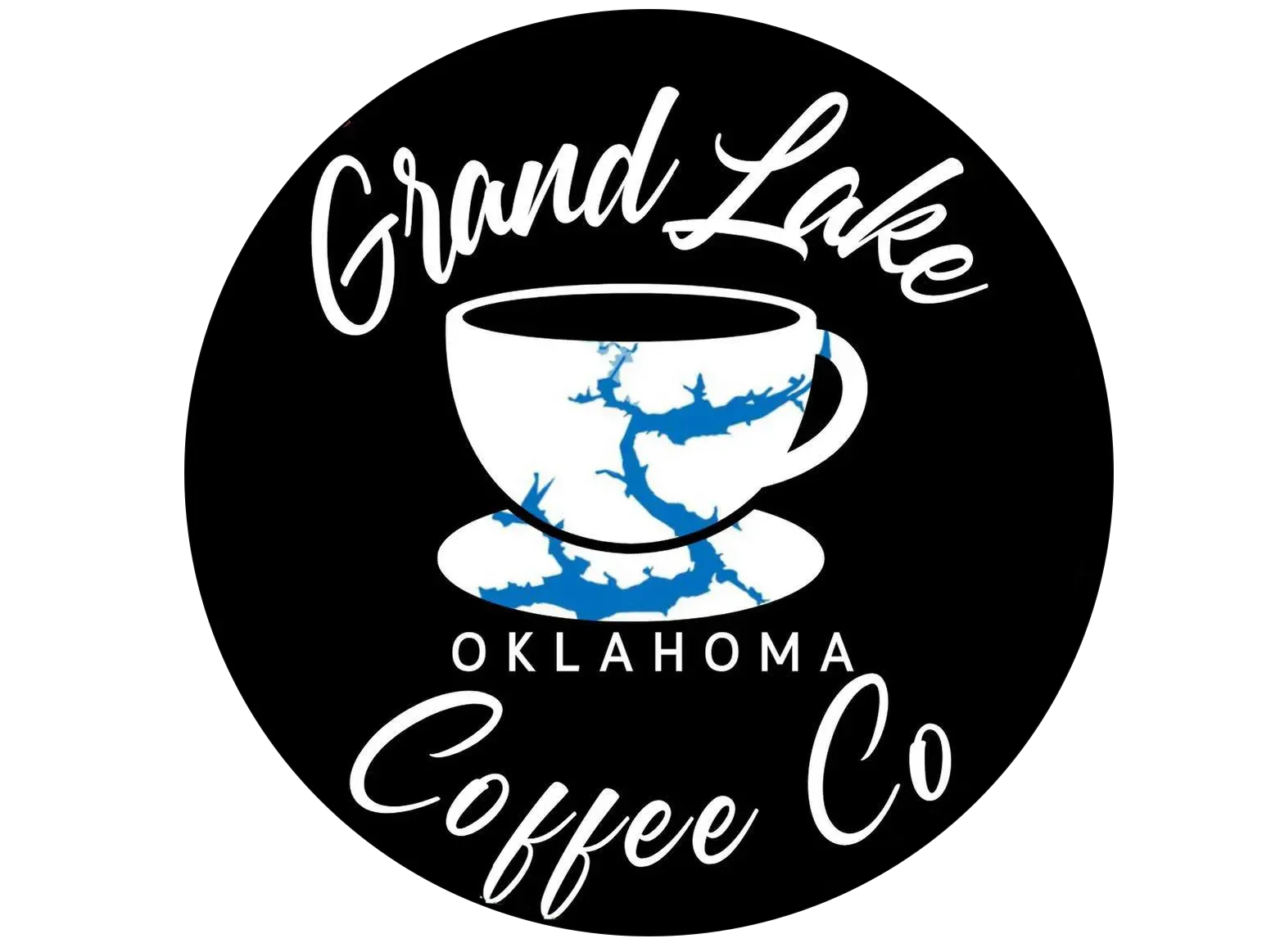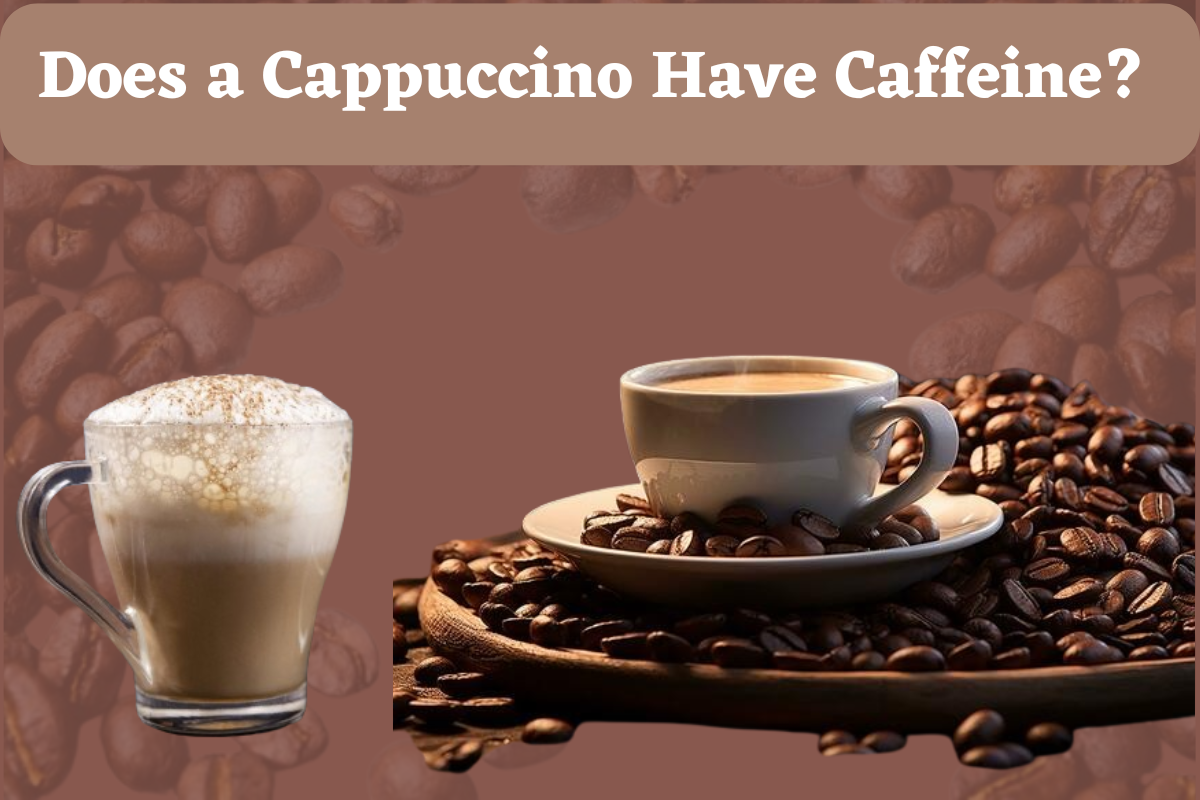Did you know your favorite cappuccino might have gotten its name from the color of a monk’s robe? The history of this beloved coffee drink is as rich as its flavor. The cappuccino’s iconic foam and creamy texture are delightful, but its base is pure espresso. That means one thing – caffeine!
If you’re looking for a satisfying way to get your energy boost, or just want to know that Does A Cappuccino Have Caffeine? the details behind that delicious frothy drink, let’s dive into the caffeinated world of the cappuccino. We’ll uncover how much caffeine hides within those velvety layers.
Importance of Knowing Caffeine Content in Cappuccino
Cappuccinos are a beloved coffee beverage enjoyed worldwide, making it essential to understand their caffeine content. While they offer a pleasurable experience with a milder espresso taste due to the milk and foam, knowing how much caffeine is in your morning indulgence is crucial.
Understanding your caffeine intake becomes vital for various reasons. Firstly, factors like the type of coffee beans used (Robusta beans generally have more caffeine than Arabica), your drink size, and even the preparation method influence the caffeine in each cup.
Secondly, some people might have the misconception that cappuccinos have significantly less caffeine simply due to the milk content. However, depending on the factors mentioned earlier, you might be getting a considerable dose.
Understanding caffeine content helps you regulate your intake accordingly. This is especially important for those sensitive to caffeine, individuals with pregnancy restrictions, or those managing conditions like heart problems or anxiety disorders where caffeine might be detrimental.
Is Cappuccino Caffeine Free?
No, a traditional cappuccino is not caffeine-free. It primarily relies on its espresso base, a coffee brew concentrated in both flavor and caffeine. Typically, an 8 fl oz cup of cappuccino contains around 86.4 mg of caffeine. However, several factors can influence this amount:
- Espresso shot size and number: The standard cappuccino includes a single shot of espresso, but additional shots or larger sizes can significantly increase caffeine content.
- Type of coffee bean: Arabica beans are most commonly used, containing about 1.5% caffeine. Robusta beans, on the other hand, have nearly double the caffeine content at around 2.7%.
- Brewing method: The method and duration of brewing espresso for a cappuccino can affect the caffeine extraction rate and volume.
- Milk and foam: While they don’t contain caffeine, the amount of milk and foam added to a cappuccino can dilute the concentration of caffeine, affecting the overall caffeine content per volume.
For those seeking a caffeine-free option, a decaf cappuccino can be prepared using decaffeinated espresso beans. However, even decaffeinated coffee may contain trace amounts of caffeine, making it important for those with sensitivities or the need to avoid caffeine to consider other alternatives or consult with a healthcare professional.
Cappuccino Variants and their Caffeine Content
Cappuccinos come in various types, each offering a unique experience in taste, texture, and caffeine content. The caffeine content in a cappuccino primarily depends on the type of espresso shot used, the size of the beverage, and the type of coffee bean. Here’s an overview of different cappuccino types and their general caffeine content:
Wet Cappuccino:
This variation includes more steamed milk and less milk foam compared to the traditional cappuccino, resulting in a creamier texture and a slightly less intense coffee flavor. However, since the amount of espresso remains the same, the caffeine content does not change significantly from the traditional version. For an 8oz cappuccino, which typically includes a single shot of espresso, the caffeine content would be around 80mg, similar to a standard cappuccino.
Dry Cappuccino:
Characterized by having more foam and less steamed milk, a dry cappuccino offers a more pronounced espresso flavor. Despite this difference in texture and taste, the espresso shot remains unchanged, thus maintaining a similar caffeine content to the traditional and wet cappuccino variants. Therefore, a single-shot dry cappuccino would also have a caffeine content of approximately 80mg for an 8oz serving.
Flavored Cappuccino:
Adding flavored syrups (like vanilla, caramel, or hazelnut) doesn’t affect the caffeine content directly. The caffeine content will still align with the base espresso shot used, typically around 80mg for a standard serving.
Iced Cappuccino:
Iced versions contain the same espresso shot as their hot counterparts, so the caffeine content remains approximately the same, around 80mg for a standard single-shot serving.
Decaf Cappuccino:
Made with decaffeinated espresso, this option has significantly less caffeine, usually about 3 to 15 mg per shot. However, it’s important to note that even decaffeinated coffee isn’t completely caffeine-free.
Cappuccino con Panna:
This variant is topped with whipped cream instead of milk foam. Since the espresso content remains the same, the caffeine content is similar to a standard cappuccino, around 80mg for a single shot.
Double or Triple Shot Cappuccino:
For those who prefer a stronger coffee, additional shots can be added. Each shot of espresso adds about 68-80mg of caffeine depending on the coffee bean and extraction method. Therefore, a double shot could contain around 160mg, and a triple shot even more.
List of Ingredients in Cappuccino
The ingredients typically found in a cappuccino include:
- Espresso: The foundation of every cappuccino! Usually, a single or double shot of espresso is used. The espresso should be made with finely ground, dark-roasted coffee beans and brewed under high pressure to create a concentrated, flavorful shot. Espresso provides the deep coffee flavor and the caffeine kick of the drink.
- Steamed Milk: Steamed milk is essential for the creamy, rich texture of a cappuccino. To make steamed milk, baristas heat regular milk to a specific temperature and use a steam wand to introduce air into the milk, creating a smooth, slightly thickened texture. Whole milk is traditional, but 2%, skim milk, or plant-based alternatives like oat milk or almond milk can also be used.
- Milk Foam: This is the airy, velvety layer that sits on top of the cappuccino. Milk foam is created by vigorously steaming the milk, which incorporates more air and creates a light, fluffy texture. The foam adds volume to the drink, provides a textural contrast, and creates a canvas for latte art.
Optional Additions
- Cocoa Powder or Cinnamon: Many cappuccinos are dusted with a sprinkle of cocoa powder or cinnamon, adding subtle sweetness and a touch of spice.
- Flavored Syrups: Sometimes, flavored syrups like vanilla, caramel, or hazelnut are added for a sweeter and more customized drink.
Cappuccino Nutritional Information
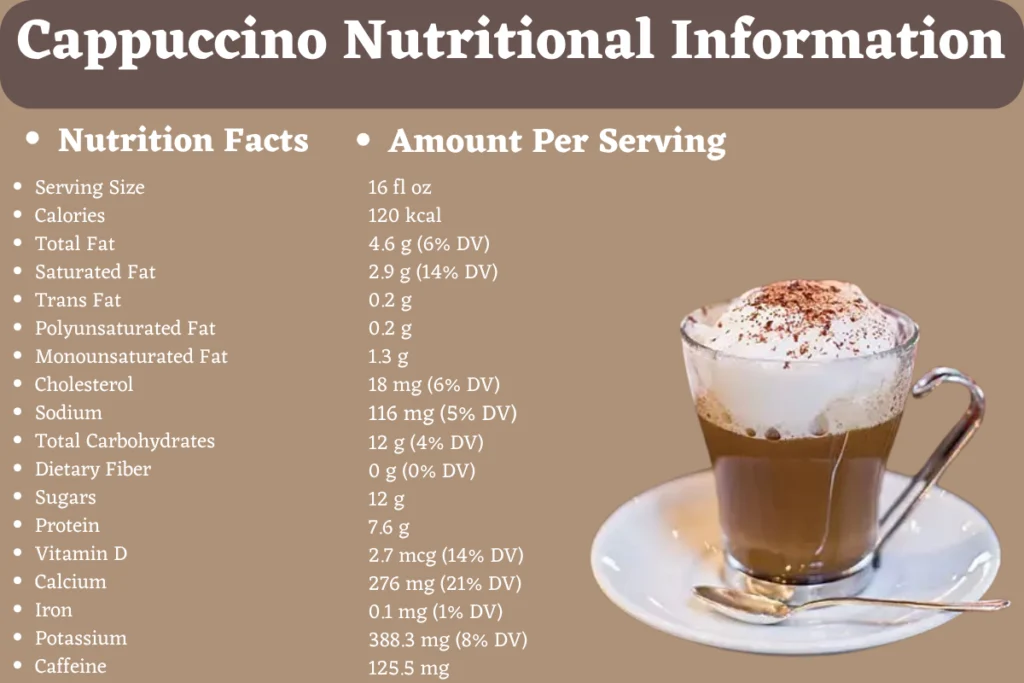
A typical 16 fl oz cappuccino contains around 120 calories. It delivers 4.6 grams of total fat, with 2.9 grams coming from saturated fat. It also contains 18mg of cholesterol and 116mg of sodium. In terms of carbohydrates, a cappuccino provides 12 grams of total carbohydrates, including 12 grams of sugar, but without any dietary fiber.
You’ll find 7.6 grams of protein in a cappuccino. Additionally, this coffee drink offers valuable nutrients like vitamin D (2.7mcg), calcium (276mg), a small amount of iron (0.1mg), and a moderate amount of potassium (388.3mg). Finally, and perhaps most importantly for coffee lovers, a 16 fl oz cappuccino typically contains about 125.5mg of caffeine.
| Nutrition Facts | Amount Per Serving |
| Serving Size | 16 fl oz |
| Calories | 120 kcal |
| Total Fat | 4.6 g (6% DV) |
| Saturated Fat | 2.9 g (14% DV) |
| Trans Fat | 0.2 g |
| Polyunsaturated Fat | 0.2 g |
| Monounsaturated Fat | 1.3 g |
| Cholesterol | 18 mg (6% DV) |
| Sodium | 116 mg (5% DV) |
| Total Carbohydrates | 12 g (4% DV) |
| Dietary Fiber | 0 g (0% DV) |
| Sugars | 12 g |
| Protein | 7.6 g |
| Vitamin D | 2.7 mcg (14% DV) |
| Calcium | 276 mg (21% DV) |
| Iron | 0.1 mg (1% DV) |
| Potassium | 388.3 mg (8% DV) |
| Caffeine | 125.5 mg |
Alternatives to Cappuccino and their Caffeine Content
For those looking to explore beyond the classic cappuccino, there are several alternative coffee beverages, each with its unique flavor profile and caffeine content. Here’s a comparison of popular alternatives:
Latte:
A latte is similar to a cappuccino but with more steamed milk and less foam, creating a creamier drink. Typically, a standard latte contains about the same amount of caffeine as a cappuccino, around 63mg per 8oz cup, as both are made with a single shot of espresso. The key difference lies in the milk-to-foam ratio, with lattes having more steamed milk and less foam compared to cappuccinos, resulting in a smoother and milkier texture.
Americano:
Made by diluting an espresso shot with hot water, it has a similar strength but different taste from a traditional espresso. The caffeine content is roughly equal to that of the espresso used, so an 8oz Americano (made from a single shot) contains about 80mg of caffeine.
Flat White:
Originating from Australia/New Zealand, this drink is similar to a latte but with a higher ratio of coffee to milk, served in a smaller cup. The caffeine content is similar to a latte and cappuccino, approximately 130 mg per 12 fl oz.
Macchiato:
A shot of espresso “stained” or “marked” with a small amount of milk. Since it’s primarily espresso, a single-shot macchiato has a caffeine content close to 85mg. The caffeine content in a macchiato is influenced by the espresso shot used.
Mocha:
A Mocha, which is a latte with chocolate syrup, typically has a higher caffeine content than a regular latte. The caffeine content in an 8oz cup of Mocha, if made with one shot of espresso, is around 152mg. This higher caffeine content is due to the addition of chocolate syrup in a Mocha.
Espresso:
While espresso is known for its strong flavor and concentrated nature, it generally contains less caffeine per serving compared to a standard cup of brewed coffee. The caffeine content in espresso can be influenced by various factors such as the type of beans used (Arabica or Robusta), the brewing method, grind size, and extraction time. An average single shot of espresso typically contains between 29-100mg of caffeine, with an average around 75mg.
Dirty Chai Latte:
This is a unique combination of a traditional chai latte (black tea mixed with spices like cinnamon, ginger, and cardamom) with a shot of espresso added. A chai latte alone has significantly less caffeine than a cappuccino, but when you add a shot of espresso to make it “dirty,” the caffeine content increases. On average, a chai latte might have about 40mg of caffeine, and adding a shot of espresso (about 80mg) brings the total to around 120mg, which can be higher than a standard cappuccino depending on how it’s made.
Cortado:
A cortado has a 1:1 ratio of espresso to steamed milk, making it a small, intense drink with a stronger coffee flavor than a cappuccino but in a smaller volume. Since it includes a single shot of espresso, the caffeine content in a cortado is similar to that of a single-shot cappuccino, about 80mg, depending on the espresso used.
Café au Lait:
This French favorite consists of equal parts brewed coffee and steamed milk. Given that brewed coffee generally has less caffeine per ounce than espresso, a café au lait will have less caffeine than a cappuccino if the volume of coffee is the same as the espresso shot used in a cappuccino. The caffeine content in brewed coffee can vary widely, but for a standard 8oz cup, it’s typically around 95mg, which means a café au lait with an equal part of milk might have slightly less caffeine than a cappuccino of the same size.
| Beverage | Caffeine Content |
| Latte | 63mg per 8 oz serving |
| Americano | 80mg per 8 oz serving (single shot) |
| Flat White | 130mg per 12 fl oz serving |
| Macchiato | 85mg per 2 oz serving |
| Mocha | 152mg per 8 oz serving (single shot) |
| Espresso | 75mg (single shot) |
| Dirty Chai Latte | 120mg |
| Cortado | 80mg |
| Café au Lait | 95mg per 8 oz serving |
Recommended Daily Intake of Cappuccino
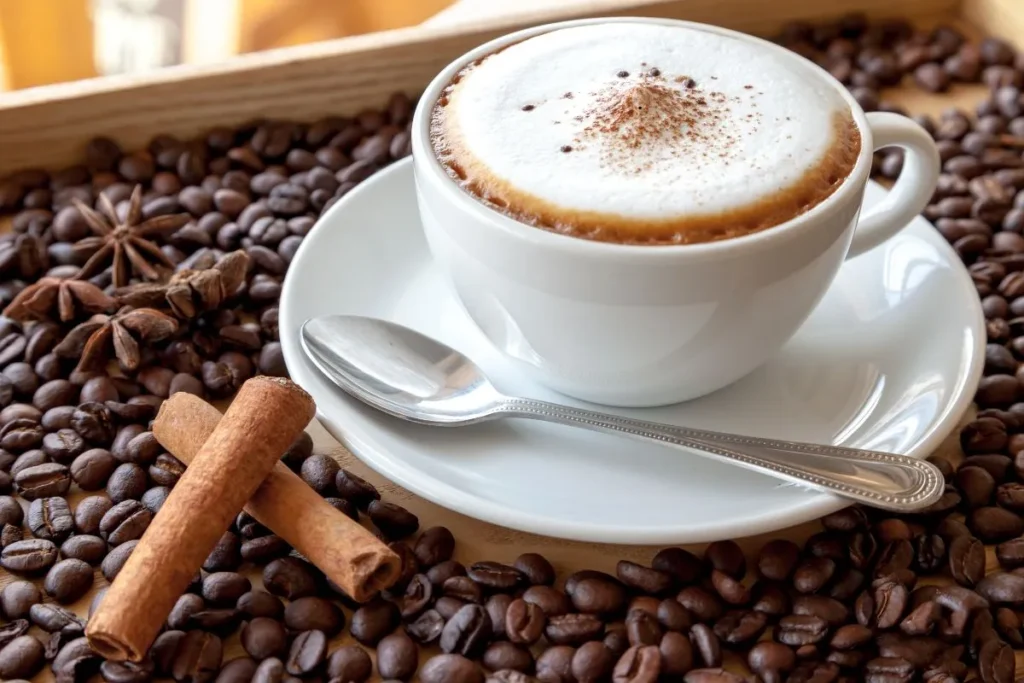
A 16 fl oz cappuccino contains around 125.5 mg of caffeine. When compared to the Recommended Daily Intake (RDI) of 400 mg of caffeine for healthy adults, a cappuccino provides a significant portion – about 31.4%.
It’s important to remember that your individual caffeine sensitivity might mean you feel jittery or experience negative effects with less than this recommended amount.
Also, keep in mind that smaller cappuccinos have less caffeine, and if you enjoy multiple cappuccinos throughout the day, you could easily exceed the RDI.
Conclusion: Does A Cappuccino Have Caffeine?
While a cappuccino’s creamy texture and delicious foam might create a sense of indulgence, it’s essential to remember that this beloved beverage does contain a significant amount of caffeine. Knowing your caffeine intake and how it affects your body is crucial.
If you enjoy the rich coffee flavor and experience of a cappuccino but want to manage your caffeine, consider smaller sizes or explore delicious alternatives such as cortados or lattes. And, for those who need to avoid caffeine completely, exploring caffeine-free options ensures you can still enjoy a comforting, warm beverage.
Frequently Asked Questions
Q1. Does decaf cappuccino contain any caffeine?
Yes, decaf cappuccinos still contain trace amounts of caffeine. The decaffeination process removes most of the caffeine, but not all. If you’re highly sensitive or must avoid caffeine completely, it’s best to choose a caffeine-free option instead.
Q2. Can I make a cappuccino without espresso?
While a traditional cappuccino requires espresso as its base, there are alternatives for those who don’t have an espresso machine. You can substitute strong brewed coffee, although the flavor won’t be as intense and you may miss the characteristic crema from espresso.
Q3. Are there any health benefits to drinking cappuccino?
Cappuccinos offer some potential benefits due to the milk content. You’ll get a dose of calcium and protein, which are important for bone health and muscle building. Additionally, the antioxidants present in coffee may offer some protective benefits. However, it’s important to be mindful of added sugar and overall calorie intake.
Q4. How much cappuccino is too much?
This depends entirely on your individual caffeine tolerance and health considerations. Generally, sticking to 1-2 cappuccinos per day and staying within the recommended daily caffeine intake of 400mg is a good guideline for healthy adults. Those with caffeine sensitivity, existing health conditions, or pregnant women should speak to their healthcare provider for personalized advice.
Q5. Is cappuccino bad for the stomach?
For some people, the combination of coffee and milk in cappuccinos can cause digestive discomfort, especially if you have lactose intolerance or sensitivities. Coffee can also stimulate acid production which might lead to heartburn or upset stomach in certain individuals. If you notice negative digestive effects after drinking cappuccinos, try reducing your intake or exploring alternatives.
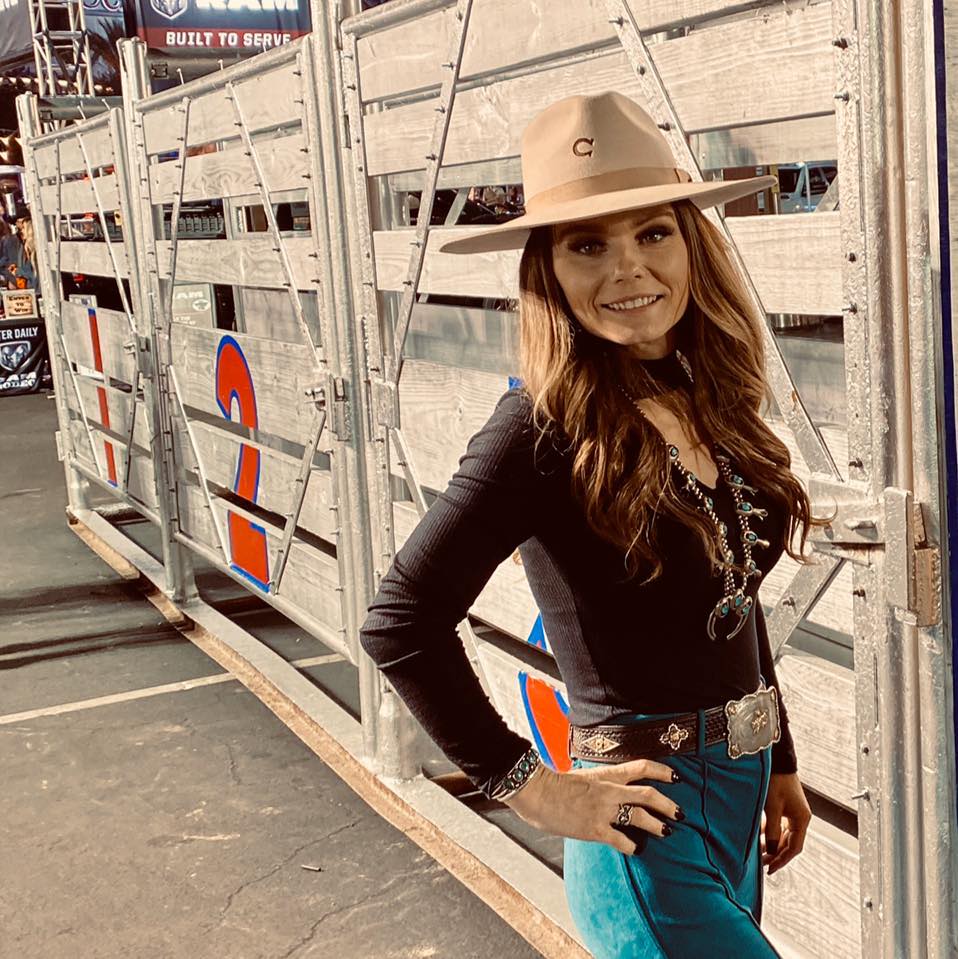
Rossi Glover, the passionate Owner of Grand Lake Coffee, infuses every cup with her love for coffee and dedication to quality. With an extensive background in the art and science of coffee, Rossi is not just a connoisseur but a storyteller, sharing the intricate tales behind each brew.
